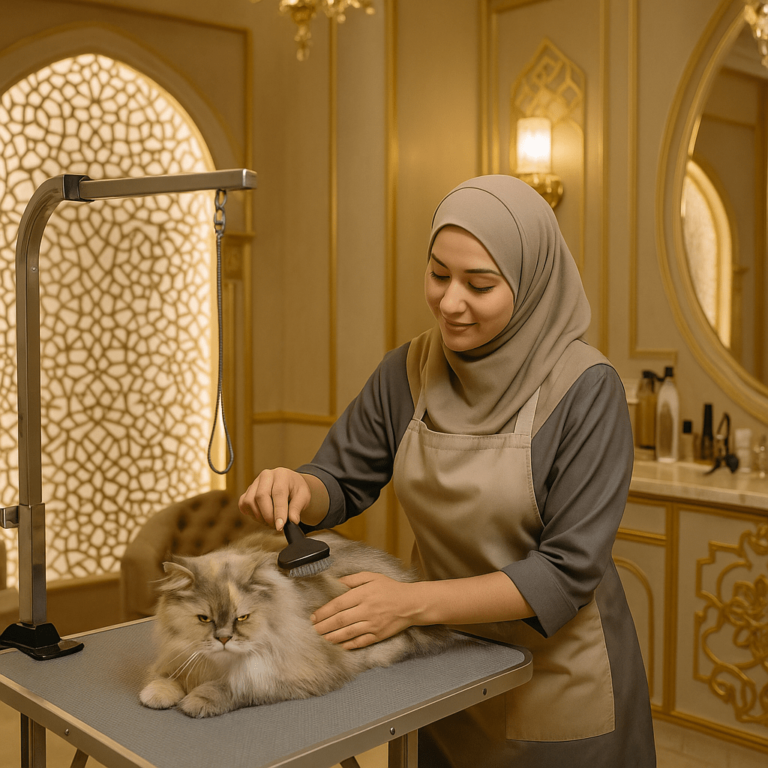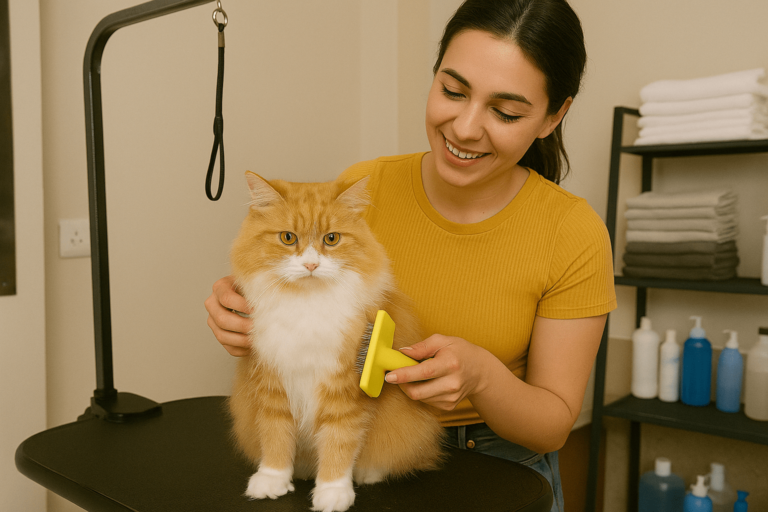
While cats are renowned for their grooming skills, it doesn’t hurt to give even the most fastidious feline just a little extra help in keeping that coat shimmering and free of tangles. The many benefits of regular brushing—keeping your cat looking great, improving health, and strengthening your bond—are unrivaled. If you are wondering where to start, this thorough step-by-step tutorial will walk you through how to brush your cat’s coat effectively and safely. Take a deep breath because grooming your cat is easier than you think!
Why Brushing Your Cat’s Coat Is Important
Brushing your cat’s coat is not just about keeping them looking good; it has numerous advantages that benefit your pet’s well-being:
Reduces Shedding: Regular brushing removes loose fur, reducing shedding and keeping your home cleaner.
Prevents Matting: Particularly for long-haired cats, brushing prevents painful tangles and mats.
Stimulates Skin Health: Brushing promotes blood circulation and distributes natural oils, keeping the coat healthy and shiny.
Minimizes Hairballs: Cats groom themselves by licking, often ingesting loose hair. Brushing reduces the amount of fur they swallow, hence reducing the chances of hairballs.
Tools You Need
Before you get started, make sure you have the right tools for your cat’s coat type. Here are a few essentials:
Slicker Brush: Excellent for working out tangles and mats in long-haired cats.
Bristle Brush: Perfect for short-haired cats to remove loose hair and dust.
Wide-Tooth Comb: Handy for working out stubborn tangles with care.
Rubber Brush or Mitt: Great for cats that don’t like normal brushes; it is gentle and massages their skin.
De-shedding Tool: Ideal for heavy shedders such as Maine Coons or Ragdolls.
Select a tool based on your cat’s coat type and sensitivity to make sure they are comfortable during grooming.
Step 1: Prepare Your Cat for Grooming
Not all cats take instantly to being brushed. Here are some tips to prepare your cat for a successful grooming session:
Choose the Right Time: Always choose a quiet moment with your cat, either when it has just finished eating or playing.
Create a Comfortable Environment: Find a quiet place that is free from distractions. Allow them to feel secure on the ground with a soft towel or blanket.
Introduce the Brush: Allow your cat to get used to the look and smell of the brush by letting them sniff it before commencing. Immediately reward curiosity with a treat or light stroking.
Start with light, quick strokes to accustom your cat. If they begin to stress or appear agitated, immediately stop and then try later.
Step 2: Correct Direction in Brushing
Brushing your cat correctly ensures that your feline stays comfortable while you achieve the best results of their grooming:
Brush with the Fur: Always brush the cat from the head towards the tail, following the direction of hair growth.
Be Gentle: Especially around the belly and legs, use light pressure.
Avoid Tugging: Work out knots and tangles gently using a wide-tooth comb. Never pull on your cat’s hair.
Step 3: Attend to the Problem Areas
There may be areas of your cat’s coat that will require a little more TLC:
Undercoat: Use a de-shedding tool for loose undercoat hair in thickly furred breeds, such as Persians.
Abdomen and Axillary: These areas may matt easily, so check regularly and use a gentle touch.
Tail: Gently brush the tail since this area can be sensitive.
Step 4: Make It a Positive Experience
To ensure that your cat associates brushing with positive feelings:
Positive Reinforcement and Treats: Reward good behavior with words of encouragement, petting, or treats.
Short Sessions: Grooming sessions should be short, especially when starting out. Gradually increase the time as your cat becomes more comfortable.
Respect Their Boundaries: If your cat becomes agitated or tries to escape, stop brushing and try again later. Forcing the process can create negative associations.
Step 5: Clean and Maintain Your Grooming Tools
After every session, clean your brushes and combs to keep them in good working condition and hygienic as well. Remove trapped fur and wash the tools if necessary with mild soap and water. Dry them properly before putting them away.
How Often to Brush Your Cat?
The frequency depends on your cat’s coat type and lifestyle:
Short-Haired Cats: Once or twice a week would be adequate.
Long-Haired Cats: Recommended daily to avoid mats and tangles.
Heavy Shedders: Increase frequency during shedding seasons, spring and fall, to manage loose fur.
Common Challenges and Solutions
Not every brushing session will go smoothly. Here are a few common problems and their solutions:
Resistance to Brushing: Switch to using a rubber brush or a grooming glove for a more gentle approach. Groom just for a minute or two and gradually increase the duration.
Tangles and Mats: Work on tangles in small sections using a wide-tooth comb. For severe mats, consider seeking professional grooming assistance.
Scratching or Biting: If your cat lashes out, pause the session and try again later. Trim their nails beforehand to minimize scratches.
When to Seek Professional Help
Sometimes, professional grooming may be necessary. Seek help if:
Your cat’s coat has severe mats that you can’t safely remove.
Your cat is extremely resistant to brushing despite your efforts.
You’re dealing with a breed that requires specialized grooming, like a Persian or Himalayan.
Professional groomers have the tools and expertise to handle even the most challenging situations while keeping your cat safe and comfortable.
The Best Cat Grooming Tips
To ensure your cat’s coat stays in top condition, incorporate these best grooming practices into your routine:
Start grooming your cat at a young age so they get used to the process.
Use appropriate grooming tools for your cat’s coat type.
Maintain a schedule for your cat’s good coat health and to reduce shedding.
Pair brushing with other care activities like nail trimming and ear cleaning.
Conclusion
Brushing your cat’s coat is not only a hygienic routine but also an opportunity to bond and show your feline love. Follow this step-by-step tutorial to make brushing stress-free and enjoyable for you and your furry friend. Regular brushing, whether your cat has a sleek, short coat or long and luxurious fur, will keep them healthy, happy, and looking their best.





